The money transfers and remittances space shifted further towards digital in 2024, though global efforts towards driving down pricing still have some way to go. In this roundup, we break down the key trends for the sector in 2024.
Markets worldwide have performed well in 2024, and the same has been true for many remittances and money transfer companies. The adoption of digital has driven much of the space’s growth across the year, while other macro trends, including growing migration, continue to evolve.
But beyond this, how has the space fared? Below are some of the top trends for remittances and money transfers in 2024.
Money transfer pricing and speeds are still over global targets
A key directive for the industry has been to make money transfers faster and less costly through a combination of better technology, regulation and partnerships. However, according to our analysis of the Financial Stability Board’s October 2024 report on these objectives, there is still a long way to go.
The report has two separate metrics relating to consumer money transfers: remittances, which typically covers the use case of migrants sending money home to friends and family, and P2P payments, which are non-remittance consumer money transfers such as moving money abroad to pay for property, school fees and other expenses. The former data is underpinned by the World Bank’s Remittance Prices Worldwide dataset, while the latter is supplied to the FSB by FXC Intelligence.
On remittances, the FSB report showed that the global average cost to send $200 rose slightly between 2023 and 2024 to 6.4%, while the cost to send $500 was flat at 4.3%. Both remain significantly higher than the UN’s goal of 3% for this send value.
Meanwhile for P2P transfers, which are more digital-led and focused on higher value use cases, the global average cost of sending $1,000 and $10,000 rose slightly over the same period to 2.6% and 1.9%, respectively. This is higher than G20’s 2027 target of 1% for these send values.
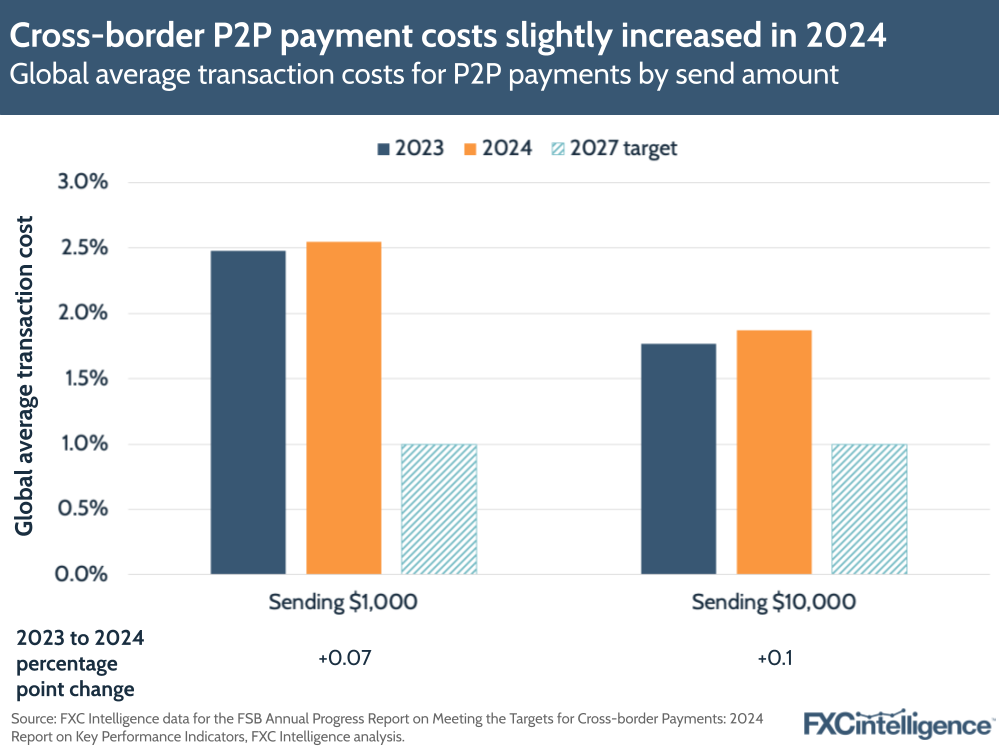
On the speed of P2P payments, the G20’s 2027 goal is for all payments to be sent in under a day, with 75% being sent in under an hour. However, this is still far from being achieved. The FSB reported that while money transfers of $1,000 and $10,0000 that were made with cash and via digital wallets mostly completed in under an hour, those sent via bank accounts saw a greater share taking over a day to arrive.
This year, it’s become increasingly clear that collaboration will be key for streamlining remittances, particularly to emerging markets where financial inclusion is still an issue.
Countries are working to build and connect instant payment networks globally, with recent examples including India’s efforts to connect its instant payments platform UPI to external networks, as well as several bilateral agreements in countries across Southeast Asia. Meanwhile, the industry has continued to explore the potential of technologies to enable faster and less costly transfers.
However, the impact of these developments could take time and, in the case of some new technologies, could require a fundamental change in financial systems or in human behaviour, particularly when it comes to Web3 and blockchain-based solutions.
Digital challenger growth continues to put pressure on incumbents
Digital players Wise and Remitly’s growth has continued to outpace other publicly traded, historically retail-focused remittances players – chiefly Intermex and Western Union – in 2024. Though Remitly and Wise are still behind Ria and Xe owner Euronet and Western Union in terms of actual revenues, their continued double-digit revenue growth is indicative of the strength of their digital model.
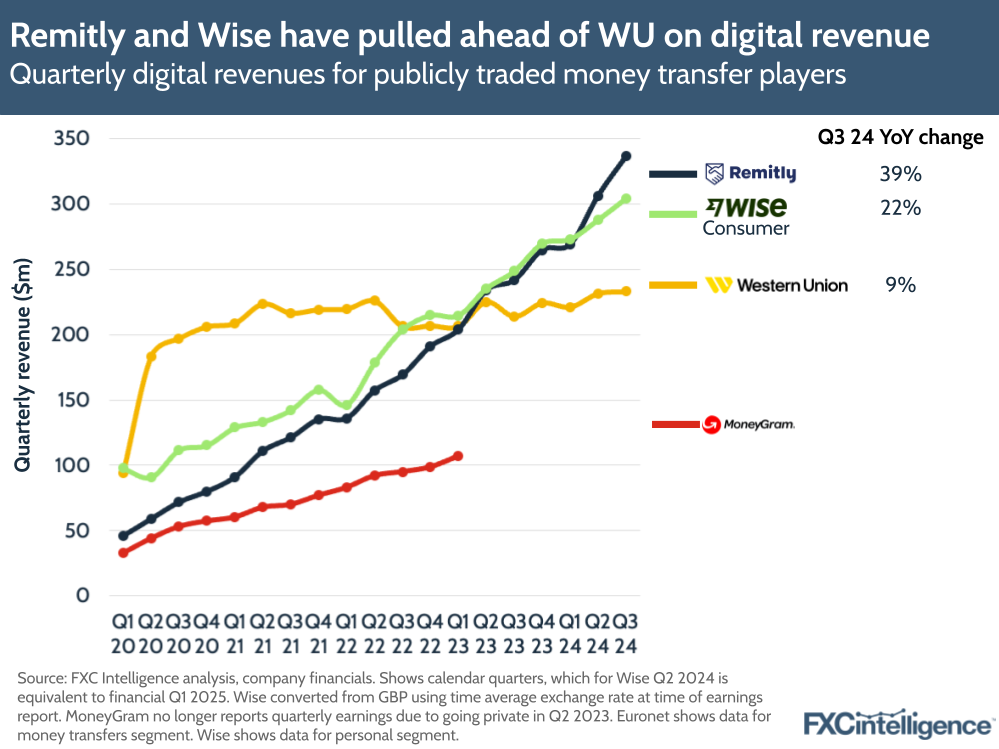
Indeed, Wise and Remitly’s revenues exceed Western Union’s digital revenues and are growing at a much faster rate. While smaller and traditionally retail-led Intermex is likely to be considerably lower. We highlighted this as part of our deep-dive report on Intermex last month, when the company announced it was putting itself up for sale in a bid to better develop its faster growing but still small digital offering amid slowing overall growth.
We also noted that in the last few quarters, Wise has pulled ahead of Western Union in terms of overall consumer send volumes and is now significantly in the lead amongst public players, although this does include some flows from the company’s B2B2X solution Wise Platform. Remitly also continues to see significant volume growth this year, up 42% YoY in the last quarter.
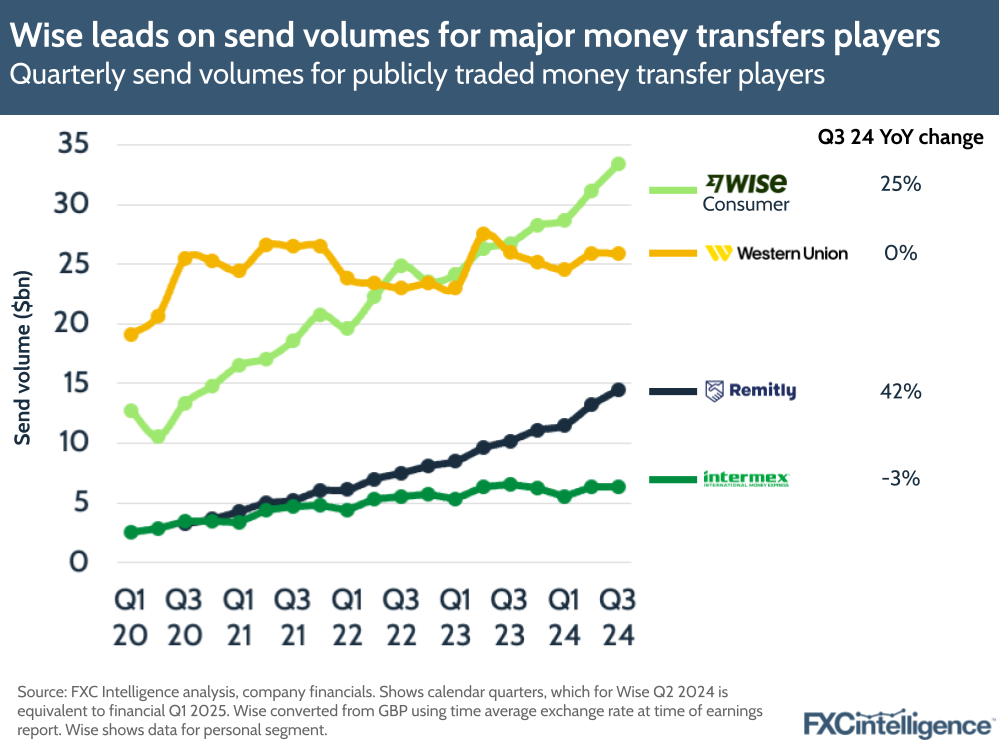
Western Union and Intermex have focus on the digital opportunity in 2024, with the topic being a key part of Western Union’s Evolve 2025 strategy, which is designed to bring the company back to growth. Meanwhile, Intermex has highlighted the need to expand its digital presence in its core US to LatAm markets, where there is current rapid digitisation in many countries.
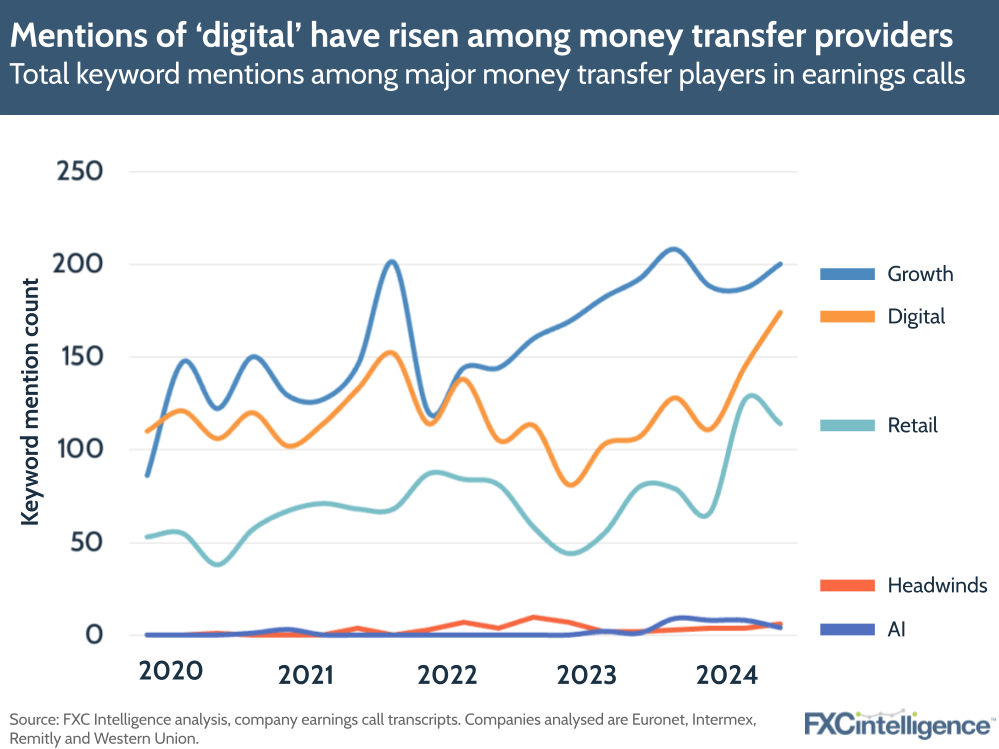
The continued importance of digital is highlighted by growing mentions of the term in money transfer providers’ earnings calls this year. Across Q1-Q3 2024 earnings calls for Euronet, Intermex, Remitly and Western Union, the term digital was mentioned 430 times, up 48% from Q1-Q3 2023. This was partly driven by Intermex, which saw the term mentioned 87 times during its Q3 2024 earnings call alone, versus 33 times in Q3 2023.
Scale has been key for remittances
Building a scalable model for money transfer business has been a key focus for companies this year. Expanding to new markets is one thing, but being able to optimise costs and drive profitability has been just as important – particularly during a more muted investment environment that values sustained profits and justified expenses.
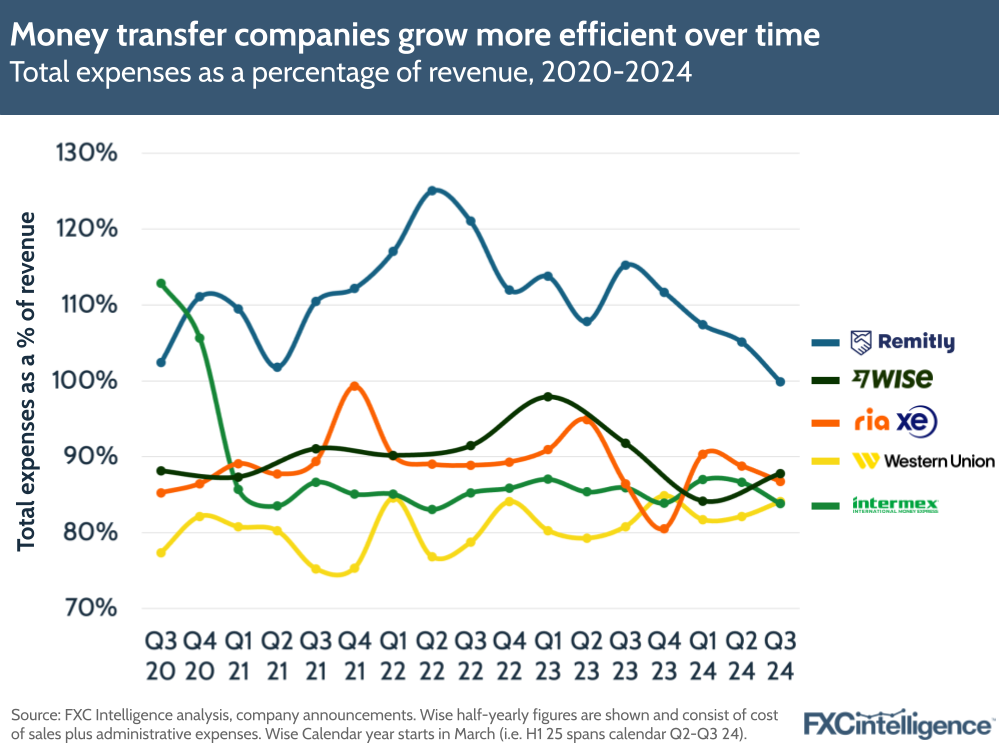
Looking at operating costs as a percentage of overall revenue highlights that as some providers have continued to grow revenues and expand their markets and customer bases this year, they have also grown more efficient in terms of overall spending. In particular, Remitly, Intermex and Euronet (through Ria and Xe), have seen this percentage decline sequentially on a quarterly basis since the start of 2024.
Meanwhile, Wise, which reports its costs of sales and administrative expenses on a half-yearly basis, saw these combined expenses form 88% of revenues for its H1 2025 period (spanning Q2-Q3 2024), versus 92% in H1 2024. By contrast, Western Union’s percentage has grown sequentially this year as the company has continued to see headwinds affecting revenues, but it has the lowest percentage alongside Intermex at 84%.
Remitly leads the others, with total costs in Q3 amounting to 99.9% of revenues, though its large investment in marketing versus others this year is paying off as the company scales. The company saw its first quarter of positive net income in Q3 of this year, driven by significant customer growth and higher send volumes. CEO Matt Oppenheimer told us that as the company has scaled, the company has been able to drive down the costs of disbursement through financial institutions in its network, which in turn means the company can pass on lower pricing to consumers.
Similarly, in its H1 2025 results, Wise said its profits reflected its ability to scale costs of goods sold relative to volumes as it continues to invest in and drive growth, with one of these investments being significantly reducing pricing for consumers. Speaking about the company’s recent India expansion, Wise told us that its focus was on building out its infrastructure, which over time allows it to scale its unit costs and make pricing more competitive against incumbent players. Marketing and competitive pricing is also allowing Wise to drive significantly higher traffic than other money transfer players.
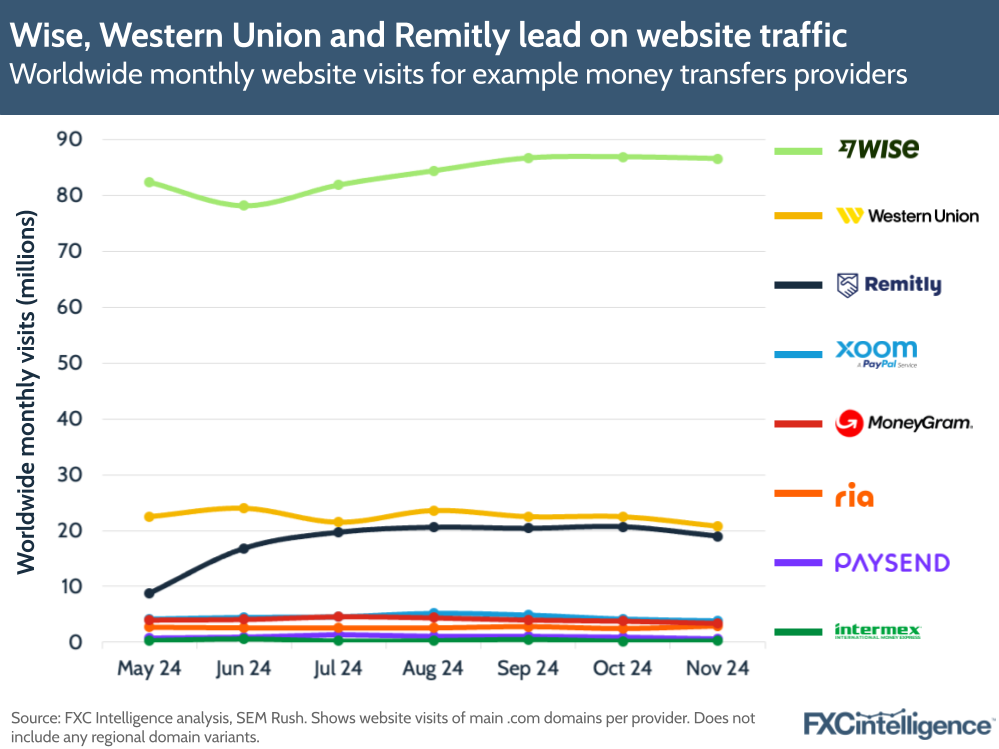
Wise is not the only player that has been expanding into new markets in 2024 as companies continue to build out infrastructure and diversify into new areas, which is also helping them build resilience against underperformance in other corridors. For example, Western Union recently announced its acquisition of Singapore-based digital wallet Dash – a move to potentially capture more remittances in the APAC region and add to its push for more digital.
Having added European receive markets through the acquisition of its competitor La Nacional in 2023, Intermex also added the UK as a send market through another unnamed buy this year, having seen an unexpected slowdown in some of its core markets. Meanwhile, UniTeller has added additional licenses in South America, Africa and Europe through its acquisition of More Payment Evolution, which has unlocked new digital opportunities, according to CEO Alberto Guerra.
Other companies in the space are increasingly looking to diversify their offerings. Revolut has announced its incoming goals for next year, spanning a variety of new products including mortgages, biometric payments and a new credit product in Europe. Meanwhile, Mama Money is among those who this year capitalised on high use of WhatsApp in Africa by integrating its money transfer service with the platform.
Stablecoins launched as crypto gains ground in emerging markets
This year, adoption of digital currencies has continued to grow in some countries around the world that are facing economic instability and inflation, but also as a means of bypassing legacy infrastructure to enable faster, less costly cross-border transactions. Blockchain-based fiat-backed stablecoins are moving beyond just being assets and in some regions are forming part of the payments infrastructure, including serving as the rails for money transfers.
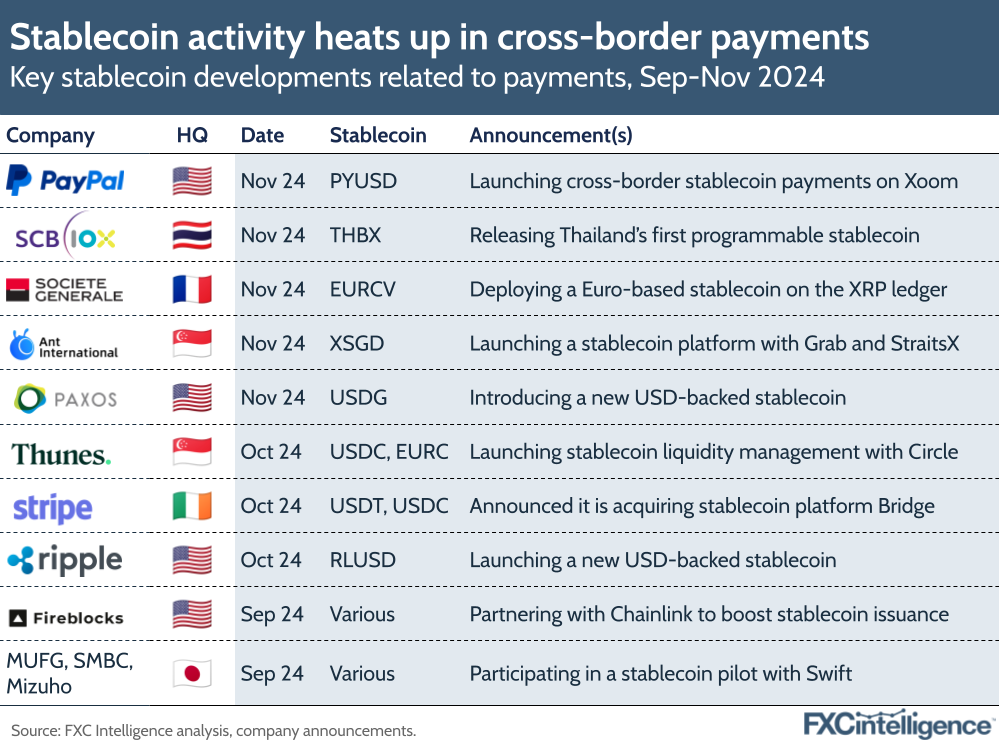
Having added support for its PYUSD stablecoin to fund remittances on Xoom earlier this year, Paypal in November announced it would be allowing its disbursement partners to settle cross-border money transfers made using PYUSD through Xoom, with the goal of providing less costly transfers to regions across APAC and Africa.
This December, Ripple also launched its RLUSD stablecoin, citing remittances and money transfers as one of its three core use cases. Meanwhile, Revolut has announced its plans to launch a stablecoin, having already introduced its own crypto exchange.
While conversation around stablecoins continues to heat up, many of the biggest remittances specialists such as Remitly, Wise, Western Union continue to focus primarily on traditional fiat services, without offering dedicated solutions for moving crypto globally. As stablecoins proliferate, it will be interesting to see if these companies do pay more attention to these industries in 2025.
Where will the money transfers space go in 2025?
As we look to 2025, digital is set to continue to dominate money transfers. The continued strength of digital-first providers is likely to continue to change the dynamic, as they continue to take share from traditional remittance players and banks. Meanwhile, such retail-focused players are set to double-down on their own efforts in this space. AI, which so far has shown success for Remitly in customer service settings, is also likely to see increasing development and adoption among money transfers players.
Continued interest in the trillion-dollar consumer money transfer market from private equity players may also drive some acquisitions in support of this, while those with money to spend could drive moves to consolidate businesses in the segment.
As cost continues to be a focus, infrastructure efforts are likely to increasingly aid improvements in this area, while increased competition, particularly in emerging markets, is likely to also play a role.



